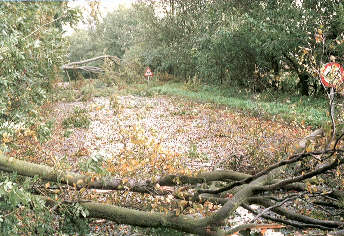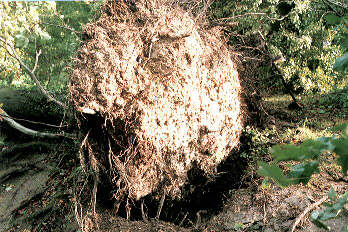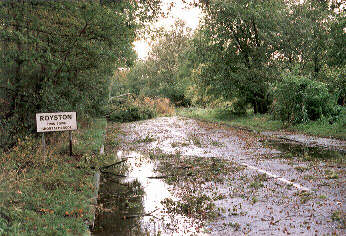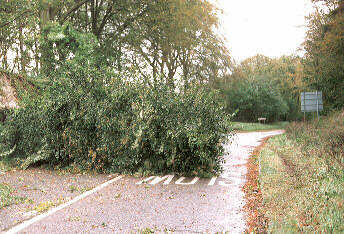



Royston (Iceni) Weather Station
The Great Storm of 16th October 1987 - 1
During the night of 15th/16th October 1987 a rapidly deepening depression swept across the country from approximately the south-west approaches to the Humber. Although the centre of this low passed some distance to the north of Royston the air pressure here nonetheless fell to a very low value of 964 mb. The rapid fall of pressure gave rise to a southerly gale in the warm sector of the depression as it passed over southern England and this was largely responsible for the widespread devastation over the country that night. As the low passed the wind veered to what was a very strong north-westerly but by this time the major damage had been done.
This storm has acquired a certain notoriety for several reasons. Firstly, the severity of its onset caught weather forecasters unawares with the result that adequate warning was not given. Secondly, it affected some of the most heavily populated parts of the country including London and so had a far greater effect on people and property than it might otherwise have done. Thirdly, it came after a very wet fortnight (91.6 millimetres of rainfall in Royston from 1st to 15th October) which loosened tree roots whilst the trees were still in full leaf, leaving the tree population very vulnerable to the strains imposed by the gale, and consequently suffering greatly. The only saving grace was that the gale occurred at night whilst most people were safely tucked up in bed.
As the pictures accompanying these notes show, Royston resembled a battleground on the morning of 16th October 1987. Uprooted trees, fallen branches, and other debris were strewn across the town and surrounding countryside. It could have been much worse but the town was afforded some protection from the southerly gale by the East Anglian Heights to the south. Surprisingly, property damage was relatively light in Royston.
This was undoubtedly one of the worst three gales in the last 30 years in Royston. The other two both came in January when the trees were bare and the strain on them reduced, but they still suffered quite badly. Also, property damage in the two January gales was quite severe. The first of these events occurred in the evening of 2nd January 1976 when the north-westerly gale set power lines in motion to such an extent that massive arcing ensued which set the sky around Royston aglow with purple flashes.
The second severe January gale was in the afternoon of 25th January 1990. The fact that this was a weekday afternoon ensured maximum disruption to people going about their daily business and to transport etc., which added to the widespread damage suffererd in Royston.
The two January gales mentioned above were arguably more severe in Royston than the notorious gale of 16th October 1987, but the latter has already entered the weather lore of the country for the reasons stated, whilst the others have been largely forgotten.
The following photographs were taken between about 0730 and 0830 GMT on 16th October 1987. Whilst the worst of the storm was over by this time a howling north-westerly wind was still blowing and holding a camera steady was no mean feat, so if you spot any camera shake you will know why!
 |
 |
| This is the scene in Newmarket Road, Royston. There is no hope for any vehicles wishing to pass as trees have fallen across the road in a number of places between the Town Hall roundabout and the by-pass. | Fallen trees bring large balls of chalk out of the ground as they are uprooted, as this picture in Newmarket Road shows. The resultant craters provide a refuge for wildlife, whilst the fallen tree trunks become a haven for beetles. |
 |
 |
| These large puddles in the Newmarket Road are a result of the heavy rainfall which was associated with the storm. The rainfall total of 23.9 millimetres in the previous 24 hours made it the wettest day of the month. | Yet another fallen tree in the Newmarket Road, this time just off the by-pass on the approach to Royston. This is close to the point where the old A505 scaled Hyde Hill through a chalk cutting (which was filled in when the by-pass was constructed in 1981/2). |
Return to Welcome to Royston (Iceni) Weather Station header page
(This page last updated 25th February 2000)